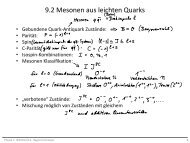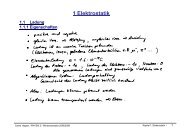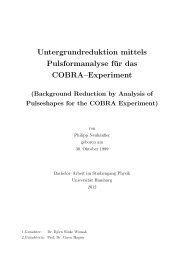Setup of a Drift Tube Muon Tracker and Calibration of Muon ...
Setup of a Drift Tube Muon Tracker and Calibration of Muon ...
Setup of a Drift Tube Muon Tracker and Calibration of Muon ...
Create successful ePaper yourself
Turn your PDF publications into a flip-book with our unique Google optimized e-Paper software.
4.1.3 Čerenkov LightČerenkov detectors are well suited for the detection <strong>of</strong> high energetic charged particles.Relativistic particles traveling through a medium with refractive index n at aspeed faster than the speed <strong>of</strong> light within this medium (β ≥ c n) generate light in aconical shape. It is emitted at an angle αcos α = 1βn .Since only particles with high velocities produce Čerenkov radiation, such a detectorcan only be used for high energetic particles. Applying photo multipliers around thedetection volume allows to observe the Čerenkov light. A particle whose track iscontained in the target can be identified by a light ring whereas a passing particleproduces a disk like shape. Shape <strong>and</strong> dimensions <strong>of</strong> these structures can be usedto obtain information on the direction <strong>and</strong> energy <strong>of</strong> the particle. The Borexinoexperiment is surrounded by a large water tank acting both as a passive shieldingagainst external background sources as well as a Čerenkov veto for cosmic muons.The signals recorded in this tank are also used for muon tracking. Čerenkov light isnot only emitted in the water tank, it also occurs when high energetic particles likecosmic muons cross the scintillator.4.1.4 Background in Liquid Scintillator DetectorsElastic scattering <strong>and</strong> inverse β decay <strong>of</strong>fer excellent detection methods <strong>of</strong> low energeticneutrinos in liquid scintillators. Unfortunately, their signatures can be mimickedby different sources <strong>of</strong> background. These originate either from radioactivecontaminations within the scintillator or the surrounding materials, or they arecaused by external radiation penetrating the detector.The dominating internal background source is 14 C which is intrinsic to the scintillator.14 C decays through a β − decay <strong>and</strong> has a half-life <strong>of</strong> 5730 years. Its naturalabundance on earth is <strong>of</strong> the order <strong>of</strong> 10 −12 . The β − decay has an end point energy<strong>of</strong> 156.475 keV. Despite the small abundance <strong>of</strong> 14 C, neutrino detection below thisthreshold is not possible.The decay <strong>of</strong> 14 C is not the only challenge when building a liquid scintillatordetector. Since it is virtually impossible to create a 100% pure scintillator, allbackground created by natural radioactivity <strong>and</strong> the abundances <strong>of</strong> radioactive elementshave to be understood <strong>and</strong> effectively reduced. The main internal backgroundsources besides 14 C are 238 U, 232 Th <strong>and</strong> 40 K as well as 222 Rn <strong>and</strong> its daughters.Furthermore, muons from the cosmic radiation create radionuclides by spallationprocesses with long half-lives. Despite the Čerenkov muon veto, the decay <strong>of</strong> theseradionclides cannot be simply vetoed since they occur long after the incident particlehas passed the detector. Due to the statistic process <strong>of</strong> radioactive decays, thetime after which the decay takes place cannot be directly correlated to the muon.The most prominet example for this cosmogenic background in liquid scintillatoris the production <strong>of</strong> 11 C, which is a β + emitter with a half-life <strong>of</strong> approximately20 minutes. As will be shown in Section 4.3, a high radio purity has been achievedfor Borexino. It will also be shown how cosmogenic events can mostly be controlled.54





